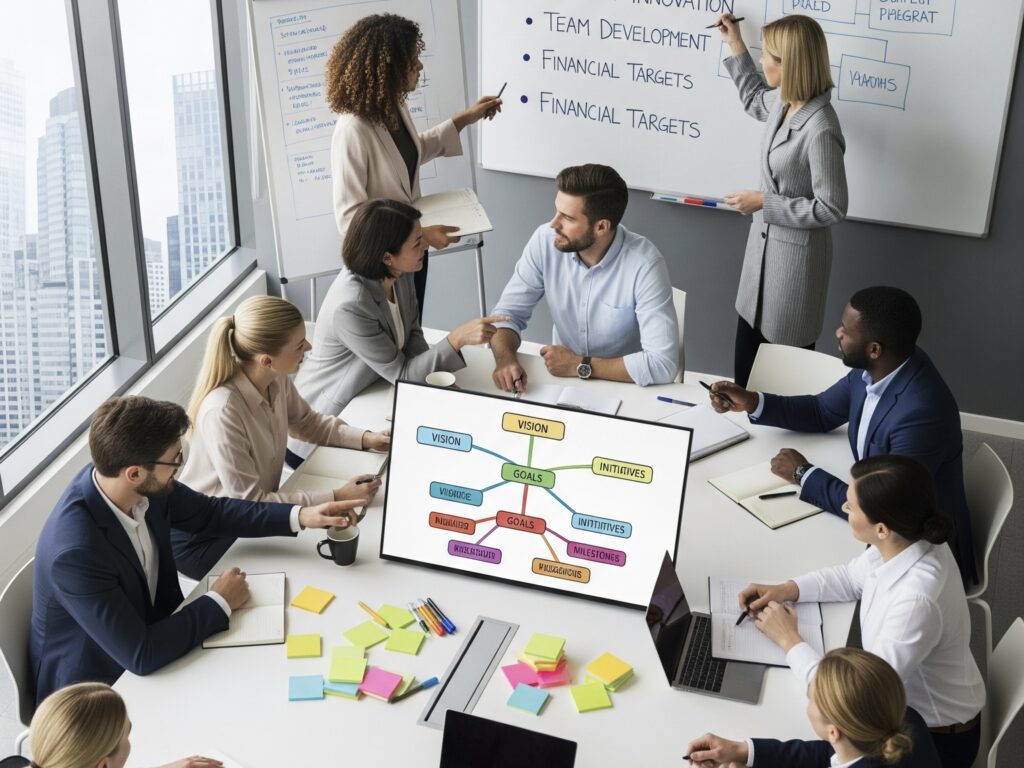Every organization has ideas visions of growth, new projects, or better ways of working. But turning those ideas into a clear, actionable strategy is often easier said than done. That’s where facilitation comes in. By guiding discussions, aligning diverse perspectives, and ensuring every voice is heard, facilitation helps transform brainstorming into concrete plans that organizations can actually implement.
In this article, we’ll explore why facilitation is so powerful in strategic planning, the key benefits it brings to leadership teams, and practical ways it ensures that big ideas don’t just stay on paper but become real-world action.
Why Strategic Planning Needs More Than Just a Meeting
Strategic planning sessions are notorious for being long, complex, and sometimes unproductive. Leaders come together with great intentions but can leave with unclear priorities or unresolved disagreements.
Common challenges include:
- Too many ideas with no clear direction.
- Dominant voices overshadowing quieter ones.
- Lack of consensus on goals and priorities.
- Plans that sound good but aren’t realistic to execute.
Facilitation addresses these challenges by bringing structure, neutrality, and clarity to the process. Instead of endless debate, a facilitator ensures focus, collaboration, and outcomes.
The Role of Facilitation in Strategic Planning
A facilitator is not there to make decisions for the group but to create the conditions for effective decision-making. In strategic planning, this includes:
- Setting the Stage – Designing the agenda, framing discussions, and creating a safe environment where ideas can flow.
- Guiding Conversations – Asking the right questions, managing time, and keeping discussions balanced.
- Aligning Perspectives – Helping the group see where they agree, where they differ, and how to find common ground.
- Turning Insights into Action – Moving from broad goals to specific, actionable steps with clear ownership.
This process ensures that strategic planning isn’t just about vision it’s about execution.
Benefits of Using Facilitation in Strategic Planning
Clarity of Direction
Facilitation helps teams prioritize what really matters. Instead of leaving with ten different goals, they leave with a clear, shared direction.
Inclusive Participation
A good facilitator ensures everyone has a voice whether they’re the CEO or a quieter team member. This leads to richer discussions and stronger buy-in.
Conflict Resolution
Disagreements are natural in strategic discussions. Facilitation provides tools for navigating conflict productively without derailing progress.
Action-Oriented Outcomes
At the end of a well-facilitated session, the group doesn’t just have ideas they have a roadmap with next steps, responsibilities, and timelines.
Sustained Momentum
By building accountability into the process, facilitation helps organizations maintain energy and follow-through long after the session ends.
How Facilitation Turns Ideas into Action
Let’s look at a typical flow of a facilitated strategic planning process:
- Visioning: Exploring the big picture what the organization wants to achieve in 3–5 years.
- Assessment: Identifying current strengths, weaknesses, opportunities, and threats.
- Prioritization: Narrowing down the most important goals.
- Strategy Building: Defining how those goals will be achieved.
- Action Planning: Assigning roles, setting deadlines, and outlining success measures.
By moving step by step, facilitation prevents the group from getting stuck in endless ideation and ensures that every idea is connected to real-world action.
Practical Tips for Successful Co-Facilitated Planning Sessions
Sometimes strategic planning involves co-facilitation two facilitators leading together. To make this work smoothly:
- Define clear roles before the session.
- Use alternating styles to keep energy fresh.
- Debrief together afterward to strengthen collaboration.
This approach adds depth and flexibility to the session, especially with large or complex groups.
Final Thoughts
Strategic planning is one of the most important processes any organization can undertake but without the right structure, it can easily stall. Facilitation bridges the gap between ideas and execution by ensuring discussions are focused, inclusive, and action-oriented.
With the right facilitation, organizations don’t just dream about the future they create a clear path to achieving it.

